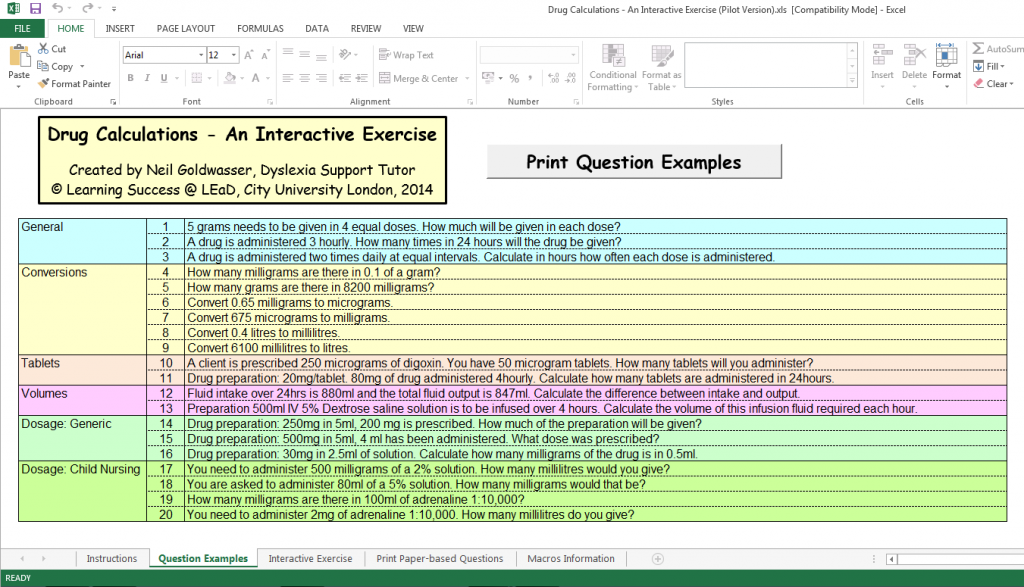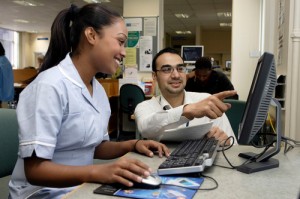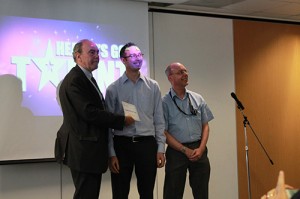I’m Neil Goldwasser, a Dyslexia Support Tutor in Learning Success, one of the 3 areas that make up LEaD, and I’ve recently designed an eLearning resource in consultation with Peter Bentley, Senior Lecturer in the School of Health Sciences. I’d like to present the results of the project so far, to demonstrate the pedagogical benefits of technology as well as those of inter-disciplinary partnerships.
People with dyslexia are often well-suited to the caring professions, and consequently nurses and midwives make up a large proportion of the students registered with Dyslexia Support here at City. I wanted to develop a supplementary, vocationally-relevant resource to help students practise lecture content and consolidate their learning. This is both for their summative assessment and to develop their professional practice. An ability to perform drug calculations is an essential skill for both the nursing and midwifery courses, as well as for the clinical practice, but this and numeracy in general is often also a source of anxiety. Recent research in the sectors of Learning Support, mathematics and nursing had additionally identified this as an area that required development, and consequently I felt this was ideal for the sort of resource with which I wanted to experiment.
The questions have been developed in collaboration with Peter to ensure sensible parameters are used in the generation of the questions. This leads to authenticity and real-world answers that the students are likely to experience in practice. They are also based on past exam papers, however my aim was to make the resource interactive and practical, and less formal: more like a ‘quiz’ than an assessment. This will hopefully be more engaging, a bit more fun, and inspire and motivate students to practise more and with less anxiety. Consequently, I chose to develop a self-marking, eLearning resource.

As a specialist support tutor, finding creative ways of providing alternative, accessible opportunities for learning is a particular focus and passion of mine. Wherever possible, I’m also keen to use the benefits of technology to enhance the learning experience (for example, compared to more traditional handouts), not just provide an alternative. I feel that in this respect, eLearning resources are a very effective model of support.
Firstly, they promote independence and self-reliance and place the learners in control; self-directed learning encourages them to take responsibility for their own learning, as well as giving them ownership. Secondly, we can reach many students this way, far more than I could in my 1:1 support sessions for example. Students can also use the resource whenever they choose and at their own pace. In particular, this provides support for students on placements, as nursing and midwifery students undertake at least 50% of their programme on clinical placements, often working 24/7 shift patterns. Additionally, some students have other commitments such as families, and might have difficulty attending 1:1s during office hours. Lastly, in the face of proposed government cuts to Disabled Students’ Allowances, we need to look at innovative new ways to support students and meet student needs.
Another rationale for choosing this style of resource was that eLearning resources can be engineered to be self-marking. This means no ‘admin’ for the students, and it also eliminates the potential for misreading or mismatching answers when marking it. Equally, there would be no need for academic and clinical link tutors to spend time marking the tests (or creating extra questions). More crucially, however, is that the students receive instant feedback, especially important for anxious learners.

Another key advantage of being computer-based was sustainability, namely that I was able to design it to be infinitely generating. Students can practise and practise until it becomes automatic, and I additionally programmed several levels of randomisation so that no two question sets would ever be the same. This enables ‘overlearning’, an increased level of rehearsal or repetition often required for students with learning differences. However, it’s important to note that this resource will benefit all students: what’s good practice regarding students with learning differences (in terms of both teaching practice and the students’ own study strategies) is often simply good practice.
In terms of the physical design, inclusivity and accessibility were both key drivers: a simple, clean design with off-white backgrounds, readable fonts and an uncluttered layout to ensure clear communication and ease of navigation and use. I feel very strongly that technology should come second place to the content, so it’s not overly ‘flashy’ unlike some commercial resources which place more importance on form than function. There is some very complex programming code, but that’s all hidden behind a user-friendly interface.
On a similar note, another principal objective was allowing for differentiated learning. Firstly, there are two versions built into the one resource; a simple button allows the user to pick between a ‘generic version’ incorporating core questions that all nurses and midwives are likely to come across in practice, or a more targeted version for those specialising in Child Nursing, which includes an additional 4 questions specific to that pathway. There is also a large degree of flexibility, since the score is marked out of how many questions the students have done, rather than them needing to tackle all ten questions each time. This means they can choose to only attempt certain question types, e.g. those they find the hardest (not wasting their limited time practising questions they get right every time), therefore meeting their individual student needs. If limited time is a particular concern, as it is for many students on placement, they can also dip in and out, for example if they only get a 10minute coffee break. Finally, being able to select which questions to attempt additionally allows for progressive learning, i.e. they can revise the questions covered in class so far and delay the others, giving students the opportunity to plan their learning and perhaps manage it in ‘chunks’.
In terms of feedback, this is sensitively conveyed when the students get an answer wrong, and also includes a specific message if units are omitted to emphasise their importance. Eliminating this habit will reduce the chances of both failing the test (this being a common reason), or causing potentially fatal mistakes in practice. Most importantly though, feedback is developmental and solution-focussed; it doesn’t just mark it as wrong, but provides the answer so that students can work backwards and discover where they made the error. This allows them to learn from their mistakes and progress in a constructive, supportive manner, encouraging a deeper understanding than just substituting the numbers into an algorithm that they might not necessarily understand. It also promotes reflection and signposts areas of difficulty, both facilitating efficient Personal Development Planning as well as enabling academic staff to target their support more effectively.
Lastly, I have still embedded the option to print paper-based questions (and answers) as an alternative. The resource can therefore be used when access to a computer is inconvenient or not possible, but fundamentally, it recognises individual preferences and differences in learning styles, for example catering for students that prefer to write things down and use highlighting strategies.
It’s this ‘student-centredness’ that is at the heart of how I work, and we’re looking forward to the next step of this project, which is to trial the resource and collate student feedback. The response from our colleagues has been very positive, and we were proud to win the gold award at the “Health Has Got Talent” Learning and Teaching Awards, but it’s also crucial that the student voice is heard. For now though, I hope this case study demonstrates not only what is achievable through eLearning packages, but also the power of collaboration, with two different subject specialists working together to improve the students’ learning experience.
Neil Goldwasser, Dyslexia Support Tutor, in collaboration with Peter Bentley, Senior Lecturer in the School of Health Sciences




This is an interesting post about your project and great to have the screen shots to see some e amples of this. It wil be interesting to how students evaluate this. Thanks for sharing this.